Data Handling and Presentation
Figure it Out (Page 75)
1. What would you do to find the most popular game among Naresh’s and Navya’s classmates?
Solution:
To find the most popular game among Naresh’s and Navya’s classmates, I would tally the number of times each game is mentioned by their classmates. The game with the highest tally would be the most popular.
2. What is the most popular game in their class?
Solution:
The most popular game in their class is Hockey.
3. Try to find out the most popular game among your classmates.
Solution: Cricket
4. Pari wants to respond to the questions given below. Put a tick [✔] for the questions where she needs to carry out data collection and put a cross [✘] for the questions where she doesn’t need to collect data. Discuss your answers in the classroom.
Figure it Out (76, 77)
1. Complete the table to help Shri Nilesh to purchase the correct numbers of sweets:
(a) How many students chose Jalebi? 6
(b) Barfi was chosen by ___ students? 9
(c) How many students chose gujiya? 5 + 5 +3 = 13
(d) Rasgulla was chosen by ___ students? 7
(e) How many students choose Gulab Jamun? 9
2. Is the above table sufficient to distribute each type of sweet to the correct student? Explain. If it is not sufficient, what is the alternative?
Solution:
No, it is not sufficient.
Shri Nilesh should have also written children’s names against each sweet item. Only then he could have given the right sweet to the right child.
Figure it Out (77, 78)
Question 1. Help her to figure out the following-
- The largest shoe size in the class is ____________
- The smallest shoe size in the class is ____________
- There are ____________ students who wear shoe size 5.
- There are ____________ students who wear shoe sizes larger than 4.
Solution:
Here let’s make the frequency table.
- The largest shoe size in the class is 7.
- The smallest shoe size in the class is 3.
- There are 10 students who wear shoe size 5.
- There are 15 students who wear shoe sizes larger than 4.
Question 2. How did arranging the data in ascending order help to answer these questions?
Solution:
Let’s arrange the data in ascending order:
3, 3, 3, 4, 4, 4, 4, 4, 4, 4, 4, 4, 5, 5, 5, 5, 5, 5, 5, 5, 5, 5, 6, 6, 6, 6, 7
It takes a bit more time to answer as compared to the frequency table.
Question 3. Are there other ways to arrange the data?
Solution: Yes, data can be arranged in descending order to find the largest values first, or grouped by frequency to quickly see the most common entries. Another method is grouping data into ranges, helping identify patterns or distributions across broader categories, making analysis more manageable and clear.
Figure it Out (Page 83)
1. The following pictograph shows the number of books borrowed by students, in a week, from the library of Middle School, Ginnori—
a. On which day were the minimum number of books borrowed?
b. What was the total number of books borrowed during the week?
c. On which day were the maximum number of books borrowed? What may be the possible reason?
Solution:
(a) Thursday
(b) Total number of books borrowed = 5 + 4 + 2 + 0 + 5 + 8 = 24 books.
(c) Saturday
As the next day is the school holiday, they would have enough time to read the books.
2. Magan Bhai sells kites at Jamnagar. Six shopkeepers from nearby villages come to purchase kites from him. The number of kites he sold to these six shopkeepers are given below—
Prepare a pictograph using the symbol to represent 100 kites.
Answer the following questions:
a. How many symbols represent the kites that Rani purchased?
b. Who purchased the maximum number of kites?
c. Who purchased more kites, Jasmeet or Chaman?
d. Rukhsana says Poonam Ben purchased more than double the number of kites that Rani purchased. Is she correct? Why?
Solution:
(a) Three symbols
(b) Poonam Ben
(c) Jasmeet
(d) Yes.
Kites purchased by Rani = 300
Kites purchased by Poonam Ben = 700
Hence Poonam Ben purchased more than double.
Answer the following questions using the bar graph:
1. In Class 2, ___________ students were absent that day.
2. In which class were the maximum number of students absent?
___________
3. Which class had full attendance that day? ___________
When making bar graphs, bars of uniform width can be drawn
horizontally or vertically with equal spacing between them; then the
Solution :
1. 5
2. Class 8
3. Class 5
Figure it Out (Page 88)
Question 1. How many total cars passed through the crossing between 6 am and noon?
Solution:
Total cars passed = 600 + 700 + 800 + 1000 + 1200 + 150 = 4450 cars
Question 2. Why do you think so little traffic occurred during the hours of 6-7 am, as compared to the other hours from 7 am to noon?
Solution:
The traffic that occurs during the hours 6-7 am is very little, as it is early morning time and there are very few office goers. Also, there are very few.
Question 3. Why do you think the traffic was the heaviest between 7 am and 8 am?
Solution:
7-8 am is the hour when the maximum number of factory officers and workers use their cars and parents use their cars to drop their children at school.
Question 4. Why do you think the traffic was lesser and lesser each hour after 8 am until noon?
Solution:
Because, most of the schools start at 8 am – and many factories also start at 8 am and hence less traffic between 8 am-9 am. Most offices start at 9 am and shops start at 10 am and hence less traffic between 9 am-10 am.
(Page 93)
Use the bar graph to answer the following questions:
1. On which item does Imran’s family spend the most and the second most?
Answer:
1. Imran’s family spends the most on food. The second most is spent on house rent.
2. Is the cost of electricity about one-half the cost of education?
Answer: Yes, the cost of electricity H400] is about halfthe cost of education R800], as i400 is exactly 50% of i800.
3. Is the cost of education less than one-fourth the cost of food?
Answer: No, the cost of education R800] is not less than one-fourth the cost of food R3400]. One-fourth of ?3400 is i850 and the cost of education is only slightly less than this, but not less than one-fourth.
Figure it Out (Page 93)
1. Samantha visited a tea garden and collected data on the insects and critters she saw there. Here is the data she collected-
Help her prepare a bar graph representing this data.
Solution:
2. Pooja collected data on the number of tickets sold at the Bhopal railway station for a few different cities of Madhya Pradesh over 2 hours.
She used this data and prepared a bar graph on the board to discuss the data with her students, but someone erased a portion of the graph.
a. Write the number of tickets sold for Vidisha above the bar.
(a) 24 tickets
b. Write the number of tickets sold for Jabalpur above the bar.
(b) 20 tickets
c. The bar for Vidisha is 6 unit lengths and the bar for Jabalpur is 5 unit lengths. What is the scale for this graph?
(c) 1 unit length = 4 tickets
d. Draw the correct bar for Sagar.
e. Add the scale of the bar graph placing the correct numbers on the vertical axis.
f. Are the bars for Seoni and Indore correct in this graph? If not, draw the correct bar(s).
(f) No. The current graph is shown in (d) and (e) above.
3. Chinu listed the various means of transport that passed across the road in front of his house from 9 am to 10 am:
(a) Prepare a frequency distribution table for the data.
(b) Which means of transport was used the most?
Solution: Bike
(c) If you were there to collect this data, how could you do it? Write the steps or process.
Solution:
Observation Timeframe
I will choose a specific timeframe, such as 9 am to 10 am, to observe the road traffic.
Recording Data
I will use a tally chart or counting app to record the type of transport passing by during that hour.
Categorisation
I will organise the data into categories (e.g., bike, car, scooter, bus, etc.).
Final Count
After the observation period, I will get the total number of occurrences for each category.
Analysis
Finally, I will prepare a frequency distribution table based on the recorded data for analysis.
4. Roll a die 30 times and record the number you obtain each time. Prepare a frequency distribution table using tally marks. Find the number that appeared:
(a) The minimum number of times.
(b) The maximum number of times.
(c) Find numbers that appeared an equal number of times.
Solution:
Let the outcomes of 30 times roll of a die be
6, 2, 3, 5, 6, 4, 1, 1, 2, 5
3, 4, 1, 1, 3, 5, 2, 2, 1, 1
6, 2, 3, 5, 1, 2, 2, 3, 4, 2
a. The minimum number of times: 3
b. The maximum number of times: 8
c. The numbers that appeared an equal number of times: 4 and 6.
5. Faiz prepared a frequency distribution table of data on the number of wickets taken by Jaspreet Bumrah in his last 30 matches:
(a) What information is this table giving?
(b) What may be the title of this table?
(c) What caught your attention in this table?
(d) In how many matches has Burnrah taken 4 wickets?
(e) Mayank says “If we want to know the total number of wickets he has taken in his last 30 matches, we have to add the numbers 0, 1, 2, 3,……..up to 7.” Can Mayank get the total number of wickets taken in this way? Why?
(f) How would you correctly figure out the total number of wickets taken by Bumrah in his last 30 matches, using this table?
Solution:
(a) The information in the table gives an overview of the number of matches in which he took wickets from 0 to 7.
(b) Frequency distribution table indicating the bowling performance of Jaspreet Bumrah.
(c) Bumrah has taken 3 or more wickets in most of the matches.
(d) Three matches
(e) No
(f) He can get the correct total, by adding the following points.
(2 × 0) + (4 × 1) + (6 × 2) + (8 × 3) + (3 × 4) + (5 × 5) + (1 × 6) + (1 × 7)
= 0 + 4 + 12 + 24 + 12 + 25 + 6 + 7
= 90
6. The following pictograph shows the number of tractors in five different villages.
Observe the pictograph and answer the following questions-
(a) Which village has the smallest number of tractors?
(b) Which village has the most tractors?
(c) How many more tractors does Village C have than Village B?
(d) Komal says, “Village D has half the number of tractors as Village E.” Is she right?
Solution:
(a) Village D
(b) Village C
(c) 3 more tractors
(d) Yes.
7. The number of girl students in each class of a school is depicted by a pictograph:
Observe this pictograph and answer the following questions:
(a) Which class has the least number of girl students?
(b) What is the difference between the number of girls in Classes 5 and 6?
(c) If 2 more girls were admitted in Class 2, how would the graph change?
(d) How many girls are there in Class 7?
Solution:
(a) Class 8
(b) Number of Girls in class 6 = 4 × 4 = 16
Number of Girls in class 5 = 4 × 3.5 = 14
Hence difference = 16 – 14 = 2
(c) Five full symbols of a girl
(d) 3 × 4 = 12 girls.
8. Mudhol Hounds (a type of breed of Indian dogs) are largely found in North Karnataka’s Bagalkote and Vijaypura districts. The government took the initiative to protect this breed by providing support to those who adopted these dogs. Due to this initiative, the number of these dogs increased. The number of Mudhol dogs in six villages of Karnataka is as follows-
Village A: 18, Village B: 36, Village C: 12, Village D: 48, Village E: 18, Village F: 24
Prepare a pictograph and answer the following questions:
(a) What will be a useful scale or key to draw this pictograph?
(b) How many symbols will you use to represent the dogs in Village B?
(c) Kamini said that the number of dogs in Village B and Village D together will be more than the number of dogs in the other 4 villages. Is she right? Give reasons for your response.
Solution:
(a) 1 * = 6 dogs will be a useful scale or key to draw this pictograph.
(b) 6 symbols.
(c) Yes, because Total no. of dogs in villages B and D = 6 + 8 = 14 dogs = 14 × 6 = 84 dogs
Total no. of dogs in remaining 4 villages = 3 + 2 + 3 + 4 = 12 dogs = 12 × 6 = 72 dogs
9. A survey of 120 school students was conducted to find out which activity they preferred to do in their free time.
Draw a bar graph to illustrate the above data taking the scale of 1 unit length = 5 students. Which activity is preferred by most students other than playing?
Solution:
10. Students and teachers of a primary school decided to plant tree saplings in the school campus and in the surrounding village during the first week of July. Details of the saplings they planted are as follows-
(a) The total number of saplings planted on Wednesday and Thursday is _____
(b) The total number of saplings planted during the whole week is ______
(c) The greatest number of saplings were planted on _____, and the least number of saplings were planted on _____.
Why do you think that is the case? Why were more saplings planted on certain days of the week and less on others? Can you think of possible explanations or reasons? How could you try and figure out whether your explanations are correct?
Solution:
(a) 30 + 40 = 70 saplings
(b) 52 + 40 + 30 + 40 + 50 + 60 + 40 = 312 saplings
(c) Saturday, Wednesday.
11. The number of tigers in India went down drastically between 1900 and 1970. Project Tiger was launched in 1973 to track and protect tigers in India. Starting in 2006, the exact number of tigers in India was tracked. Shagufta and Divya looked up information about the number of tigers in India between 2006 and 2022 in 4-year intervals. They prepared a frequency table for this data and a bar graph to present this data, but there are a few mistakes in the graph. Can you find those mistakes and fix them?
Solution:
Yes, there are a few mistakes in the graph.
- No. of tigers in 2006 was 1400 but shown less in the graph.
- No. of tigers in 2014 was 2200 but shown more in the graph.
- No. of tigers in 2018 was 3000 but shown less in the graph.
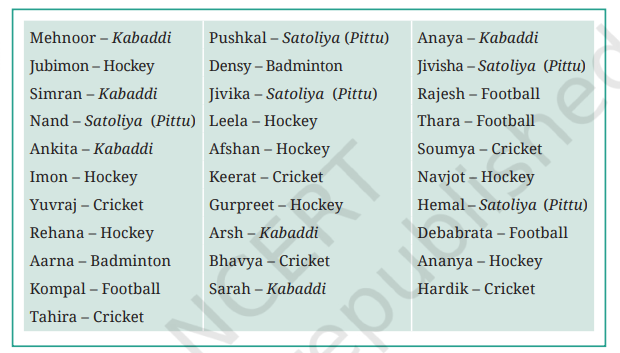



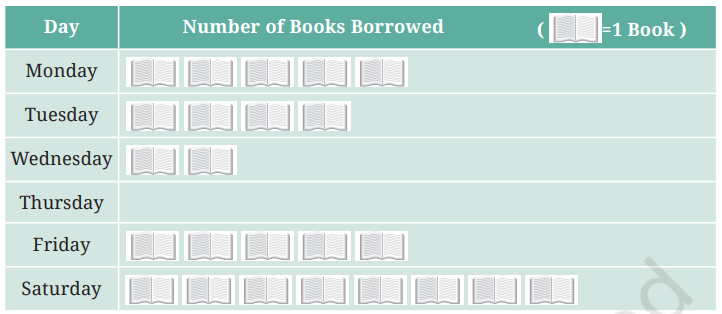
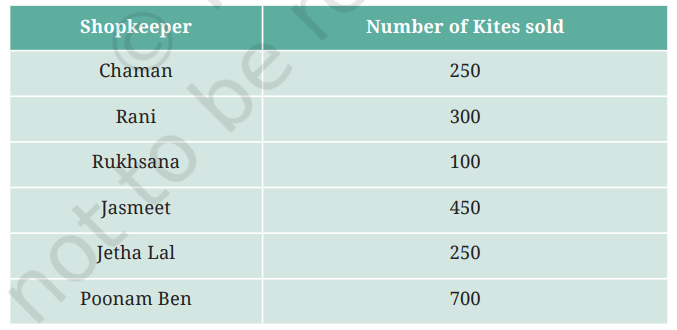

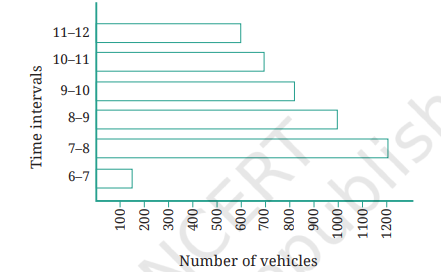
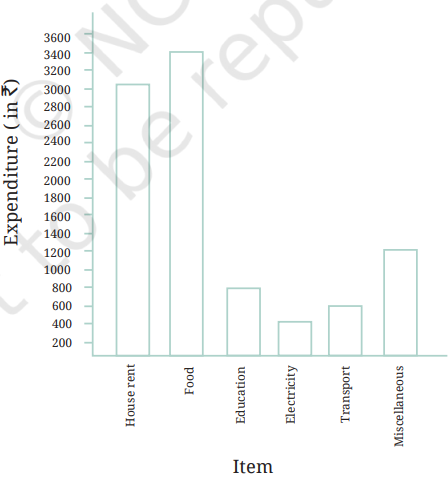



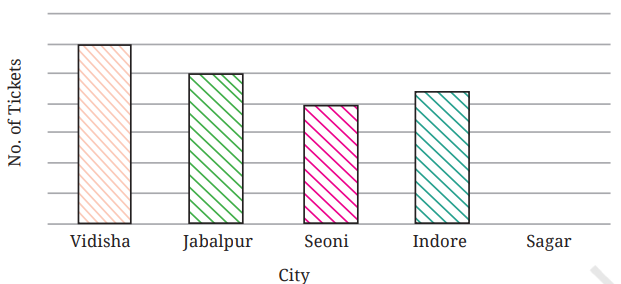


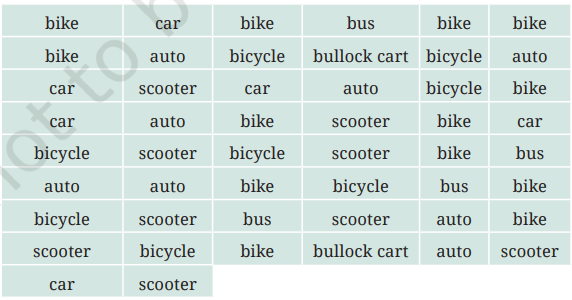
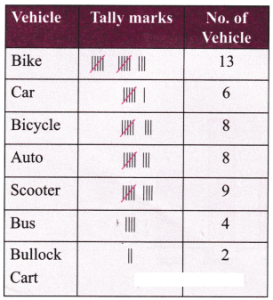

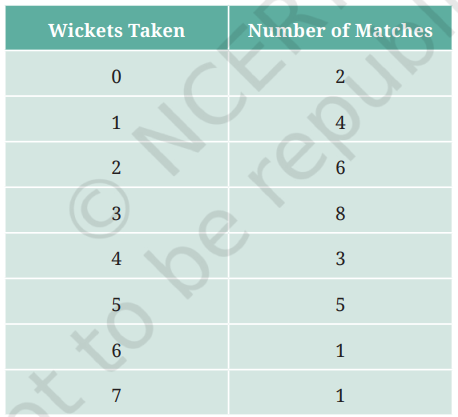
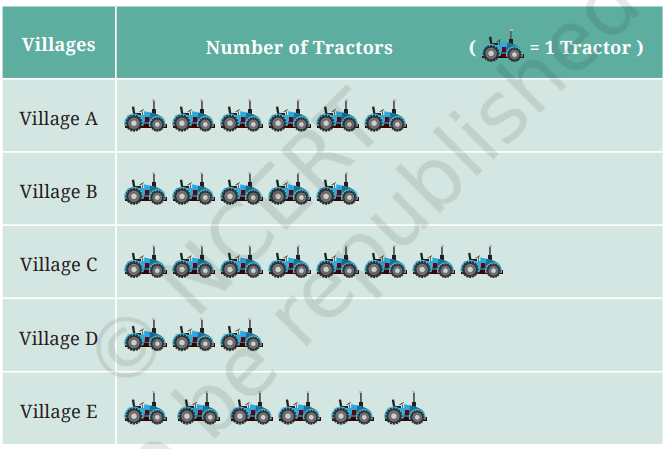
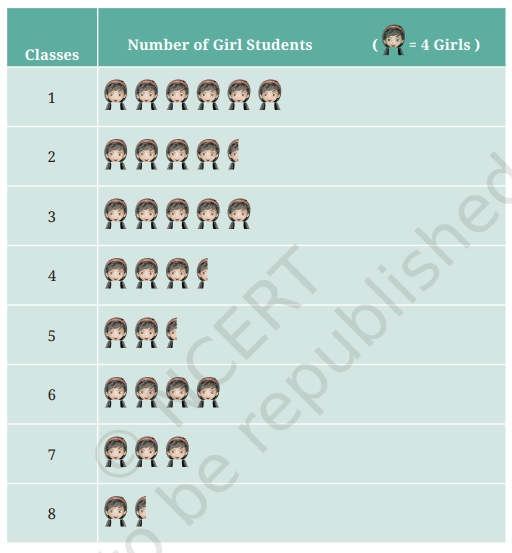

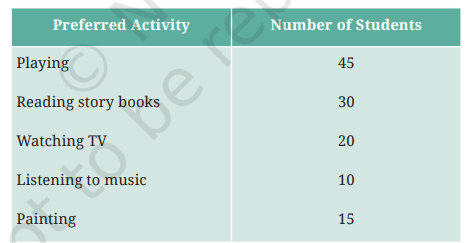

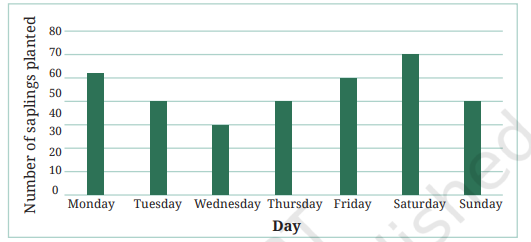
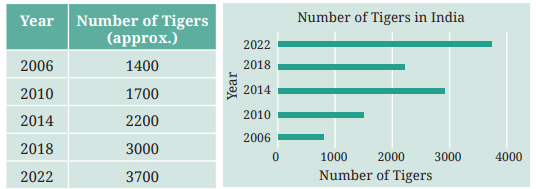
Leave a Reply